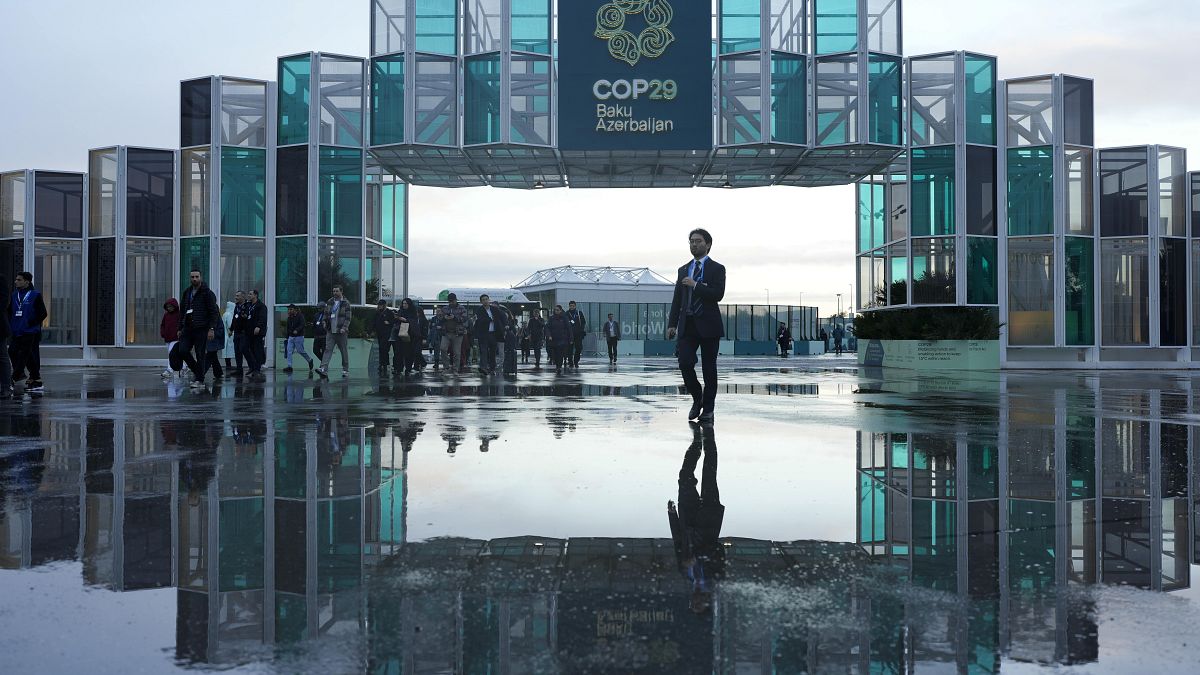Frustration rises as COP29 climate summit enters it last week

The COP29 climate summit is midway through now and negotiators are trying to hammer out a deal that might be worth hundreds of billions of dollars.
Several experts have said one trillion dollars a year or more is needed both to compensate for such damages and to pay for a clean-energy transition that most countries can’t afford on their own.
But the previous goal of $100 billion annually until 2025 was only met two years ago.
Now, the “new collective quantified goal” aims for at least ten times that, according to the UN’s trade and development organisation, or UNCTAD.
“The goal should start from 1.1 trillion for next year. And this is more or less in the same range that has been proposed by other studies too,” Rebeca Grynspan, UNCTAD’s Secretary General, told Euronews.
The question now is not only whether states will put their hands in their pockets and stump up the cash, but whether they will act quickly.
“We expect governments to actually be seized with the same level of engagement and intensity as when the global financial crisis hit and we expect action,” John WH Denton, the Secretary General of the International Chamber of Commerce, said.
And even if the money is forthcoming well developed projects to combat climate change have to be in place and ready to implement.
“Having a goal is not the solution per se. It’s a means. But what is also very important is a commitment taken by all the countries around the world about their national contribution and what kind of objectives they set for themselves, in terms of level of renewables, getting out of coal, getting out of gas,” Odile Renaud-Basso, the president of the European Bank for Reconstruction and Development told Euronews.
“So, the national objective each country sets for itself is very important also. Because having money without projects will not deliver anything.”
Frustration is rising
So far observers have been disappointed at the slow pace of progress.
“This has been the worst first week of a COP in my 15 years of attending this summit,” said Mohamed Adow, of climate think tank Power Shift Africa. “There’s no clarity on the climate finance goal, the quality of the finance or how it’s going to be made accessible to vulnerable countries.”
“I sense a lot of frustration, especially among the developing country blocks here,” he said.
Panama environment minister Juan Carlos Navarro agreed, telling The Associated Press he is “not encouraged” by what he’s seeing at COP29 so far.
“What I see is a lot of talk and very little action,” he said, noting that Panama is among the group of countries least responsible for warming emissions but most vulnerable to the damage caused by climate change-fuelled disasters.
“We must face these challenges with a true sense of urgency and sincerity,” he said. “We are dragging our feet as a planet.”
Samir Bejanov, the deputy lead negotiator of this year’s climate talks, said in a news conference that the climate finance talks were moving too slowly.
“I want to repeat our strong encouragement to all parties to make as much progress as possible,” he said. “We need everyone to approach the task with urgency and determination.”
Fossil fuel giants cast a shadow over the summit
On Friday environmental advocates released reports decrying fossil fuel industry influence at the climate talks called COP29. At the same time, a letter signed by a former United Nations secretary-general and ex-top climate negotiators called for dramatic reform. And the conference’s chief negotiator said current talks were going too slowly.
All that put the focus on process — not results.
A letter signed by former U.N. chief Ban Ki-Moon, former U.N. climate secretary Christiana Figueres and former Ireland President Mary Robinson called for “a fundamental overhaul of the COP.”
“We need a shift from negotiation to implementation,” it said.
Two signees — Figueres and Johan Rockstrom, director of the Potsdam Institute for Climate Impact Research — said the letter was being badly misinterpreted as criticism of the climate talks. They said the letter was intended to show support for the process, which they said has worked and just needs to shift into a new mode.
Instead of spending so much effort negotiating new deals in annual conferences that can attract 70,000 people, the process should be smaller and more frequent and aimed at putting what was already agreed upon into action, Rockstrom said.
“It’s about strengthening the COP,” Rockstrom said. “It’s about recognising we’ve accomplished so much that we have what we need. … We really need to get serious about delivery.”
And an analysis from the Kick Big Polluters Out coalition said on Friday that the official attendance list of the talks featured at least 1,770 people connected to fossil fuel interests.
Catherine Abreu, director of the International Climate Politics Hub, suggested that there should be a “firewall” between fossil fuel lobbyists, U.N. climate bodies and negotiators from countries. “We know over 1,700 fossil fuel lobbyists are here at COP29. That is not acceptable,” she said.
Former U.S. Vice President Al Gore, who on Friday presented new data on carbon pollution sites, said “it’s unfortunate that the fossil fuel industry and the petrostates have seized control of the COP process to an unhealthy degree.”
For his part, COP29 negotiator Rafiyev defended the process.
“The process has already delivered, the COP process so far by reducing projected warming, delivering finance to those in need,” Rafiev said. “It’s better than any alternative.”
Who are the big polluters?
Also at the talks on Friday, new data from an organisation co-founded by Gore that combines observations and artificial intelligence found that cities in Asia and the United States emit the most heat-trapping gas, with Shanghai the most polluting.
Using observations and artificial intelligence, Climate Trace quantifies heat-trapping carbon dioxide, methane and nitrous oxide, as well as other traditional air pollutants worldwide, including for the first time in more than 9,000 urban areas.
Seven states or provinces spew more than one billion metric tons of greenhouse gases, all of them in China, except Texas, which ranks sixth.
Earth’s total carbon dioxide and methane pollution grew 0.7% to 61.2 billion metric tons with the short-lived but extra potent methane rising 0.2%. The figures are higher than other datasets “because we have such comprehensive coverage and we have observed more emissions in more sectors than are typically available,” said Gavin McCormick, Climate Trace’s co-founder.
Shanghai’s 256 million metric tons of greenhouse gases led all cities and exceeded those from the nations of Colombia or Norway. Tokyo’s 250 million metric tons would rank in the top 40 of nations if it were a country, while New York City’s 160 million metric tons and Houston’s 150 million metric tons would be in the top 50 of countrywide emissions. Seoul, South Korea, ranks fifth among cities at 142 million metric tons.
“One of the sites in the Permian Basin in Texas is by far the No. 1 worst polluting site in the entire world,” Gore said. “And maybe I shouldn’t have been surprised by that, but I think of how dirty some of these sites are in Russia and China and so forth. But Permian Basin is putting them all in the shade.”
China, India, Iran, Indonesia and Russia had the biggest increases in emissions from 2022 to 2023, while Venezuela, Japan, Germany, the United Kingdom and the United States had the biggest decreases in pollution.
World News || Latest News || U.S. News
Source link



